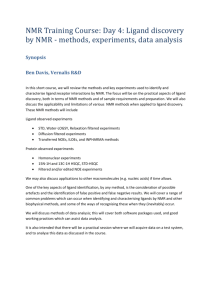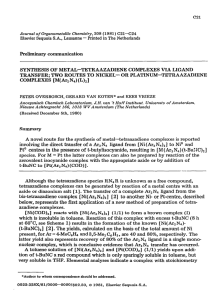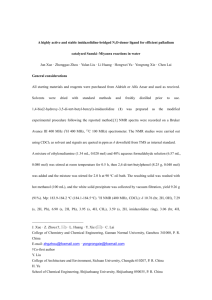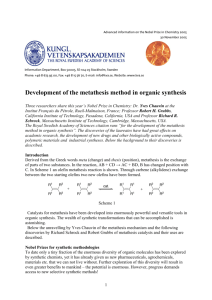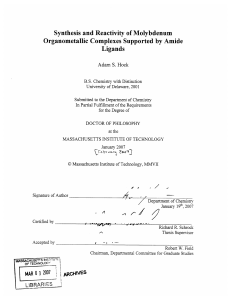RSC ChemComm Template (PC) - eCrystals
advertisement
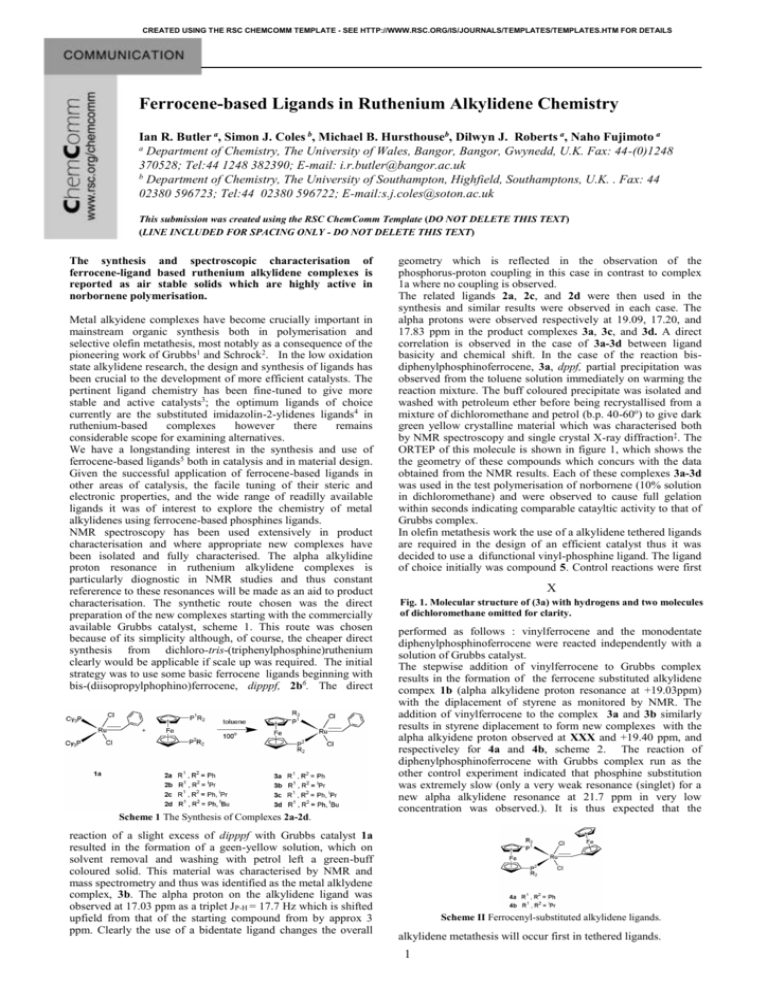
CREATED USING THE RSC CHEMCOMM TEMPLATE - SEE HTTP://WWW.RSC.ORG/IS/JOURNALS/TEMPLATES/TEMPLATES.HTM FOR DETAILS
Ferrocene-based Ligands in Ruthenium Alkylidene Chemistry
Ian R. Butler a, Simon J. Coles b, Michael B. Hursthouseb, Dilwyn J. Roberts a, Naho Fujimoto a
a
Department of Chemistry, The University of Wales, Bangor, Bangor, Gwynedd, U.K. Fax: 44-(0)1248
370528; Tel:44 1248 382390; E-mail: i.r.butler@bangor.ac.uk
b
Department of Chemistry, The University of Southampton, Highfield, Southamptons, U.K. . Fax: 44
02380 596723; Tel:44 02380 596722; E-mail:s.j.coles@soton.ac.uk
This submission was created using the RSC ChemComm Template (DO NOT DELETE THIS TEXT)
(LINE INCLUDED FOR SPACING ONLY - DO NOT DELETE THIS TEXT)
The synthesis and spectroscopic characterisation of
ferrocene-ligand based ruthenium alkylidene complexes is
reported as air stable solids which are highly active in
norbornene polymerisation.
Metal alkyidene complexes have become crucially important in
mainstream organic synthesis both in polymerisation and
selective olefin metathesis, most notably as a consequence of the
pioneering work of Grubbs1 and Schrock2. In the low oxidation
state alkylidene research, the design and synthesis of ligands has
been crucial to the development of more efficient catalysts. The
pertinent ligand chemistry has been fine-tuned to give more
stable and active catalysts3; the optimum ligands of choice
currently are the substituted imidazolin-2-ylidenes ligands4 in
ruthenium-based
complexes
however
there
remains
considerable scope for examining alternatives.
We have a longstanding interest in the synthesis and use of
ferrocene-based ligands5 both in catalysis and in material design.
Given the successful application of ferrocene-based ligands in
other areas of catalysis, the facile tuning of their steric and
electronic properties, and the wide range of readilly available
ligands it was of interest to explore the chemistry of metal
alkylidenes using ferrocene-based phosphines ligands.
NMR spectroscopy has been used extensively in product
characterisation and where appropriate new complexes have
been isolated and fully characterised. The alpha alkylidine
proton resonance in ruthenium alkylidene complexes is
particularly diognostic in NMR studies and thus constant
refererence to these resonances will be made as an aid to product
characterisation. The synthetic route chosen was the direct
preparation of the new complexes starting with the commercially
available Grubbs catalyst, scheme 1. This route was chosen
because of its simplicity although, of course, the cheaper direct
synthesis from dichloro-tris-(triphenylphosphine)ruthenium
clearly would be applicable if scale up was required. The initial
strategy was to use some basic ferrocene ligands beginning with
bis-(diisopropylphophino)ferrocene, dipppf, 2b6. The direct
Scheme 1 The Synthesis of Complexes 2a-2d.
reaction of a slight excess of dipppf with Grubbs catalyst 1a
resulted in the formation of a geen-yellow solution, which on
solvent removal and washing with petrol left a green-buff
coloured solid. This material was characterised by NMR and
mass spectrometry and thus was identified as the metal alklydene
complex, 3b. The alpha proton on the alkylidene ligand was
observed at 17.03 ppm as a triplet JP-H = 17.7 Hz which is shifted
upfield from that of the starting compound from by approx 3
ppm. Clearly the use of a bidentate ligand changes the overall
geometry which is reflected in the observation of the
phosphorus-proton coupling in this case in contrast to complex
1a where no coupling is observed.
The related ligands 2a, 2c, and 2d were then used in the
synthesis and similar results were observed in each case. The
alpha protons were observed respectively at 19.09, 17.20, and
17.83 ppm in the product complexes 3a, 3c, and 3d. A direct
correlation is observed in the case of 3a-3d between ligand
basicity and chemical shift. In the case of the reaction bisdiphenylphosphinoferrocene, 3a, dppf, partial precipitation was
observed from the toluene solution immediately on warming the
reaction mixture. The buff coloured precipitate was isolated and
washed with petroleum ether before being recrystallised from a
mixture of dichloromethane and petrol (b.p. 40-60o) to give dark
green yellow crystalline material which was characterised both
by NMR spectroscopy and single crystal X-ray diffraction‡. The
ORTEP of this molecule is shown in figure 1, which shows the
the geometry of these compounds which concurs with the data
obtained from the NMR results. Each of these complexes 3a-3d
was used in the test polymerisation of norbornene (10% solution
in dichloromethane) and were observed to cause full gelation
within seconds indicating comparable catayltic activity to that of
Grubbs complex.
In olefin metathesis work the use of a alkylidene tethered ligands
are required in the design of an efficient catalyst thus it was
decided to use a difunctional vinyl-phosphine ligand. The ligand
of choice initially was compound 5. Control reactions were first
X
Fig. 1. Molecular structure of (3a) with hydrogens and two molecules
of dichloromethane omitted for clarity.
performed as follows : vinylferrocene and the monodentate
diphenylphosphinoferrocene were reacted independently with a
solution of Grubbs catalyst.
The stepwise addition of vinylferrocene to Grubbs complex
results in the formation of the ferrocene substituted alkylidene
compex 1b (alpha alkylidene proton resonance at +19.03ppm)
with the diplacement of styrene as monitored by NMR. The
addition of vinylferrocene to the complex 3a and 3b similarly
results in styrene diplacement to form new complexes with the
alpha alkyidene proton observed at XXX and +19.40 ppm, and
respectiveley for 4a and 4b, scheme 2. The reaction of
diphenylphosphinoferrocene with Grubbs complex run as the
other control experiment indicated that phosphine substitution
was extremely slow (only a very weak resonance (singlet) for a
new alpha alkylidene resonance at 21.7 ppm in very low
concentration was observed.). It is thus expected that the
Scheme II Ferrocenyl-substituted alkylidene ligands.
alkylidene metathesis will occur first in tethered ligands.
1
CREATED USING THE RSC CHEMCOMM TEMPLATE - SEE HTTP://WWW.RSC.ORG/IS/JOURNALS/TEMPLATES/TEMPLATES.HTM FOR DETAILS
SHELXL-97 programs were used for structure solution and refinement.
33883 reflections collected, 9187 independent [R(int) = 0.0525], giving
R1 = 0.0385 for observed unique reflections [F2 > 2(F2)] and wR2 =
0.0947 for all data. The max. and min. residual electron densities on the
final difference Fourier map were 1.126 and –1.262eÅ-3, respectively.
The mixed vinylphosphine ligand 5 was prepared using
† Footnotes should appear here. These might include comments
relevant to but not central to the matter under discussion, limited
experimental and spectral data, and crystallographic data.
Scheme III Ligand metathesis reaction.
conventional synthetic methodology and this was reacted with
Grubbs complex initaily under ambient conditions. It was
evident that a rapid reaction took place even at ambient
temperature with the observation of the alpha alkylidene protons
1. selected references (a) M. Trnka and R.H. Grubbs Acc. Chem. Res.,
2001, 34, 18. and references therein (b) B. R. Maughon,; R. H. Grubbs,
Macromolecules 1997, 30, 3459. (c) Z. Wu, S. T. Nguyen,. R. H..
Grubbs,; , J. W Ziller.. J. Am. Chem. Soc. 1995, 117, 5503. (d) Cucullu,
M. E.; Li, C.; Nolan, S. P.; Nguyen, S. T.; Grubbs, R. H..
organometallics 1998, 17, 5565. (e) M. Ulman, R.H. Grubbs,
Organometallics 1998, 17, 2484. (f) M. Ulman, T.R. Belderrain,R.H.
Grubbs, Tetrahedron Lett. 2000, 41, 4689. (g) D. .J. O'Leary, H. E.
Blackwell,R.A. Washenfelder, K. Miura, R.H. Grubbs, Tetrahedron
Lett. 1999, 40, 1091.
2. (a) R.R. Schrock, Tetrahedron 1999, 55, 8141. (b) J. H. Oskam, R.
R. Schrock, J.Amer.Chem. Soc. 1993, 115, 11831.(c) R. R. Schrock, J.
S. Murdzek, G. C. Bazan, J. Robbins, M. DiMare, M. O'Regan, J.
Amer.Chem. Soc. 1990, 112, 3875. (d) R. Toreki, R. R. Schrock, .
J.Amer.Chem.Soc. 1990, 112, 2448. (e) C. J.Schaverien, J.C. Dewan,
R.R. Schrock, J.Amer.Chem.Soc. 1986, 108. 2771.(f) S.M. Rocklage,
J.D.Fellmann, G.A.
Rupprecht, L.W. Messerle,R.R. Schrock,
J.Amer.Chem.Soc. 1981, 103, 1440. (g) D.R. Cefalo, A.F. Kiely, M.
Wuchrer,
J. Y. Jamieson, R.R.Schrock,A.H.
Hoveyda,
J.Amer.Chem.Soc.
2001, 123, 3139 (h) J.H. Wengrovius,R.R.
Schrock, M.R. Churchill, J.R. Missert,W.J. Youngs, J.Amer.Chem.Soc.
1980, 102, 4515. (i) G. S. Weatherhead, J. H. Houser, J.G. Ford, J. Y.
Jamieson, R.R. Schrock, A.H. Hoveyda, H. Tetrahedron Lett.
2000, 41, 9553.(j) S. L..Aeilts, D.R. Cefalo, P. J. Bonitatebus, J. H.
Houser, A. H. Hoveyda, R..R. Schrock, Angew.Chem.Int.Ed. 2001,
40, 1452.
X
at 20.28 ppm as a doublet, however the starting complex was
present even when a three fold excess of the ligand was added
therefore an equilibrium exists. The phosphorus NMR spectrum
indicated the presence of several products in solution in addition
to the expected product 6. When this reaction was carried out
under identical conditions to those used for the syntheses of
complexes 3a-d a green yellow powder, which was observed to
be highly active in norbornene polymerisation could indeed be
isolated athough attempts at recrystallisation of this material
failed. The subsequent work was carried out on the reaction of a
ferrocene-based trisphosphine ligand to investigate whether the
use of a tridentate phosphine of this type would diplace the
alkylidene ligand in addition to the cyclohexylphosphine
ligands..The ligand chosen for this study
was bis-(1'diphenylphosphinoferrocenyl)phenylphosphine, trifer, 7.7
At 25o in CDCl3 in an NMR experiment the reaction is very
slow with the observation of new small ferrocene resonaces at
and a weak alpha alklylidene proton resonance at +20.6 ppm
after 1h. After standing for 30h. it is evident that a new complex
is present however the reaction is clearly not a clean one as
interpeted from the NMR data. The reaction of at 80 o of trifer
with Grubbs catalyst leads to the rapid removal of the alkilydene
ligand in addition to the phosphines however again the reaction
is not a clean one Attempts to crystallise the product led to the
formation of a green-yellow powder with dark microcrystals
which desolvated on moderate drying. The phosphorus NMR of
the powder obtained from the reaction of excess trifer with
Grubbs complex indicated that a ruthenium ferrocenyl phosphine
complex had formed (resonance observed at +26.55 ppm and
+127.94 resonances) however there was also evidence for a
pendant phosphine ( -18 ppm).
The latter behaviour is similar to that recently observed by us in
related reactionsof ruthenium trifer complexex.8 In conclusion it
is evident that these new ferrocene-based complexes will be
useful materials to investigate in olefin metathesis and
polymerisation reactions.
4. (a) M. Scholl, T. M. Trnka, J. P Morgan, , R. H. Grubbs, Tetrahedron
Lett. 1999, 40, 2247. (b) T Weskamp,.; F. J Kohl,.; W. A Herrmann, J.
Organomet. Chem. 1999, 582, 362-365. (c) T Weskamp,.; F. J Kohl,.; W
Hieringer,.; D Gleich,.; W. A. Herrmann, Angew. Chem., Int. Ed. 1999,
38, 2416. (d) L Ackermann, A Fürstner.; T Weskamp,.; F. J.; Kohl, W.
A Herrmann, Tetrahedron Lett. 1999, 40, 4787-4790. (e) J Huang.; E. D
Stevens,.; S. P Nolan, J. L Petersen. J. Am. Chem. Soc. 1999, 121, 2674.
(f) M. Scholl, S. Ding, S.;C. W. Lee, R. H. Grubbs, R. H.., Org. Lett.
1999, 1, 953-956.
5. (a) I.R. Butler, M.G.B. Drew, C.H. Greenwell, E. Lewis, M. Plath, S.
Mussig, J. Szewczyk, Inorg. Chem. Commun.,1999, 2, 576. (b) I.
R..Butler, S Mussig, M Plath, Inorg. Chem. Commun, 1999, 2, 424. (c)
A.L. Boyes, I.R.Butler, S.C. Quayle, Tetrahedron Lett. 1998, 39, 7763.
(d) I.R. Butler, W.R. Cullen, S.J. Rettig, ASC White, J. Organomet.
Chem. 1995, 492,157. (e) I. R. Butler, M Kalaji, M. Hursthouse, A..I.
Karaulov, KMLA Malik J.. Chem. Soc.-Chem. Commun. 1995, 459
I.R. Butler, Polyhedron, 1992, 11, 3117
6. Butler, IR Cullen WR Kim, TJ, Synth. React. Inorganic Met.-Org.
Chem. 1985, 15, 109.
7. (a) Butler, IR Davies, RL Synthesis, 1996, 1350. (b) I.R.Butler, S. J.
Coles, M. Fontani, M.B. Hursthouse, E. Lewis, KLMA Malik, M.
Meunier, and P. Zanello, J. Organomet. Chem. 2001, 637, 538.
Notes and references
† Dichlorobis(diisopropylphosphineferrocene)benzyldeneruthenium (1b)
Yield = 67.94mg, 82.22%, Melting Point = Decomposes without melting
1
H NMR (CDCl3) = 1.12-2.58 dd, 12H), 4.39 (2H, Cp), 4.47 (4H, 2
overlapping resonances, Cp), 4.68 (2H of Cp ring), 7.68 (t, meta-protons
on phenyl ring, 3JH-H = 6.89Hz), 8.60 (s, agostic phenyl proton i.e ortho
proton), 17.03 (t, carbene proton Ru =CH, JC-P = 17.72Hz) {H}31P NMR
(CDCl3) ; = 57.66 (s, PiPr2 group), Low Resolution Fast Atom
Bombardment MS: Calculated for C29H42FeRuP2Cl2 M+ = 680.416;
found 460, 645[-35, loss of Cl], 609 [-35, loss of the other Cl]
‡ Crystallographic data: C43H38Cl6FeP2Ru, Monoclinic, space group
P21/c, a = 13.9569(2), b = 14.6122(2), c = 20.0025(4)Å, =
98.6830(10), U = 4032.58(11)Å3, Dc = 1.625Mg m-3, Z = 4, T = 120(2)
K, orange block, 0.18 x 0.14 x 0.06mm3. Data collection was carried out
using an Enraf Nonius KappaCCD area detector and SHELXS-97 and
2
CREATED USING THE RSC CHEMCOMM TEMPLATE - SEE HTTP://WWW.RSC.ORG/IS/JOURNALS/TEMPLATES/TEMPLATES.HTM FOR DETAILS
Single Column Figure/Scheme
X
X
Fig./Scheme XX Caption.
X
(X)
X
Double Column Figure/Scheme
Table XX Caption
X
a
Footnote text.
Single Column Uncaptioned Graphic/Unnumbered Equation
Table XX Caption
X
a
Footnote text.
Double Column Uncaptioned Graphic
Numbered Equation
Single Column Table
Double Column Table
3



